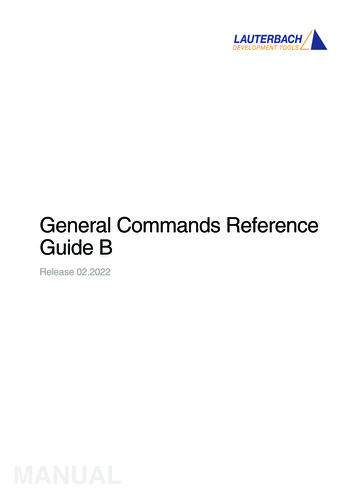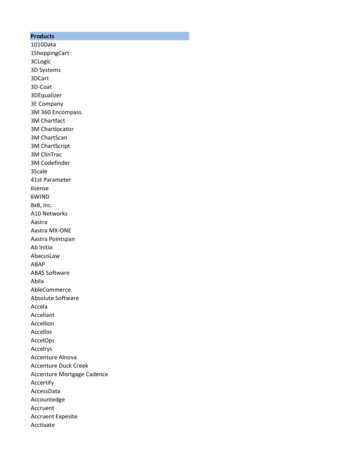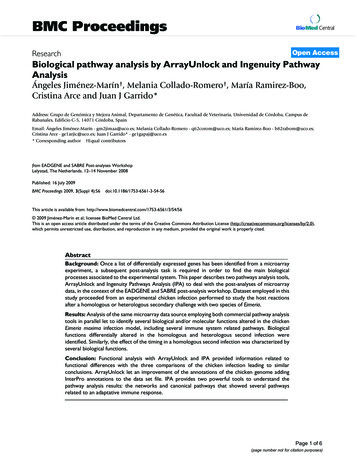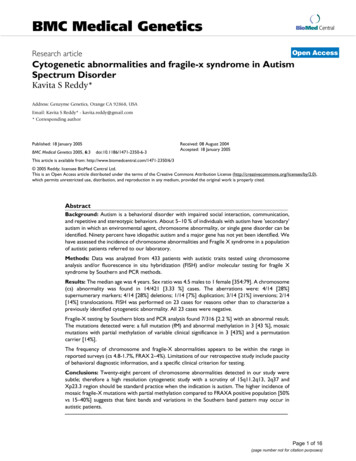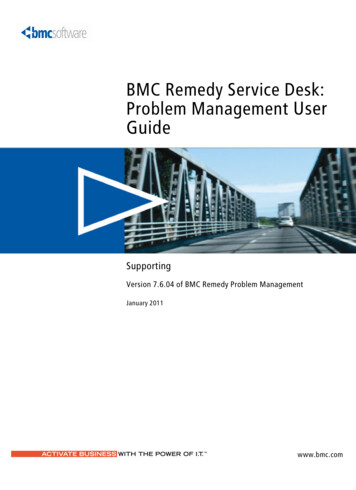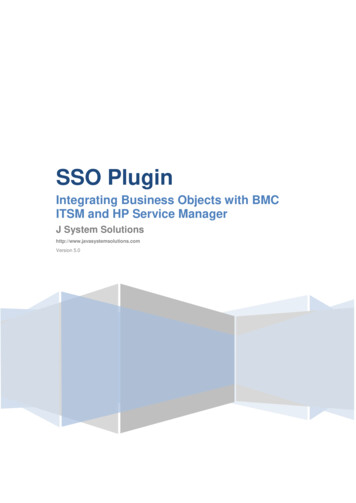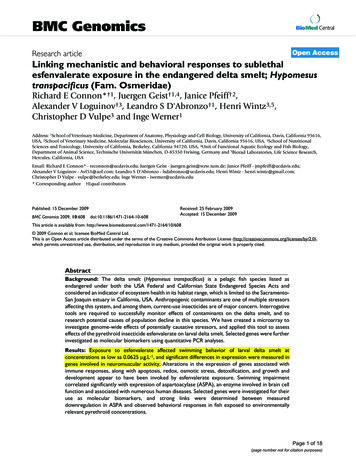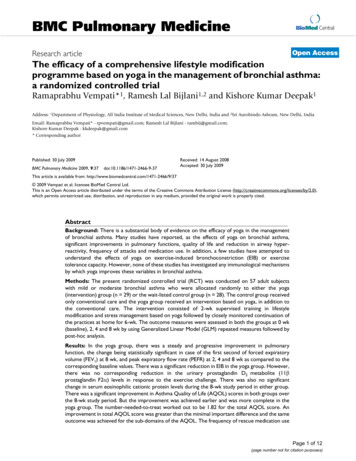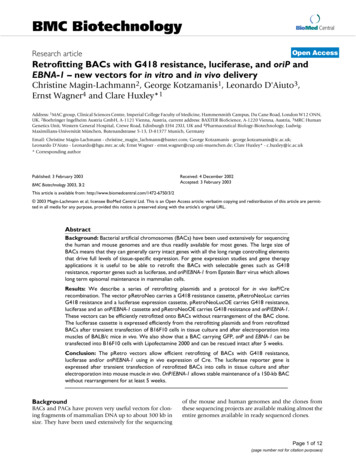
Transcription
BMC BiotechnologyBioMed CentralOpen AccessResearch articleRetrofitting BACs with G418 resistance, luciferase, and oriP andEBNA-1 – new vectors for in vitro and in vivo deliveryChristine Magin-Lachmann2, George Kotzamanis1, Leonardo D'Aiuto3,Ernst Wagner4 and Clare Huxley*1Address: 1MAC group, Clinical Sciences Centre, Imperial College Faculty of Medicine, Hammersmith Campus, Du Cane Road, London W12 ONN,UK, 2Boehringer Ingelheim Austria GmbH, A-1121 Vienna, Austria, current address: BAXTER BioScience, A-1220 Vienna, Austria, 3MRC HumanGenetics Unit, Western General Hospital, Crewe Road, Edinburgh EH4 2XU, UK and 4Pharmaceutical Biology-Biotechnology, LudwigMaximilians-Universität München, Butenandstrasse 5-13, D-81377 Munich, GermanyEmail: Christine Magin-Lachmann - christine magin lachmann@baxter.com; George Kotzamanis - george.kotzamanis@ic.ac.uk;Leonardo D'Aiuto - Leonardo@hgu.mrc.ac.uk; Ernst Wagner - ernst.wagner@cup.uni-muenchen.de; Clare Huxley* - c.huxley@ic.ac.uk* Corresponding authorPublished: 3 February 2003BMC Biotechnology 2003, 3:2Received: 4 December 2002Accepted: 3 February 2003This article is available from: http://www.biomedcentral.com/1472-6750/3/2 2003 Magin-Lachmann et al; licensee BioMed Central Ltd. This is an Open Access article: verbatim copying and redistribution of this article are permitted in all media for any purpose, provided this notice is preserved along with the article's original URL.AbstractBackground: Bacterial artificial chromosomes (BACs) have been used extensively for sequencingthe human and mouse genomes and are thus readily available for most genes. The large size ofBACs means that they can generally carry intact genes with all the long range controlling elementsthat drive full levels of tissue-specific expression. For gene expression studies and gene therapyapplications it is useful to be able to retrofit the BACs with selectable genes such as G418resistance, reporter genes such as luciferase, and oriP/EBNA-1 from Epstein Barr virus which allowslong term episomal maintenance in mammalian cells.Results: We describe a series of retrofitting plasmids and a protocol for in vivo loxP/Crerecombination. The vector pRetroNeo carries a G418 resistance cassette, pRetroNeoLuc carriesG418 resistance and a luciferase expression cassette, pRetroNeoLucOE carries G418 resistance,luciferase and an oriP/EBNA-1 cassette and pRetroNeoOE carries G418 resistance and oriP/EBNA-1.These vectors can be efficiently retrofitted onto BACs without rearrangement of the BAC clone.The luciferase cassette is expressed efficiently from the retrofitting plasmids and from retrofittedBACs after transient transfection of B16F10 cells in tissue culture and after electroporation intomuscles of BALB/c mice in vivo. We also show that a BAC carrying GFP, oriP and EBNA-1 can betransfected into B16F10 cells with Lipofectamine 2000 and can be rescued intact after 5 weeks.Conclusion: The pRetro vectors allow efficient retrofitting of BACs with G418 resistance,luciferase and/or oriP/EBNA-1 using in vivo expression of Cre. The luciferase reporter gene isexpressed after transient transfection of retrofitted BACs into cells in tissue culture and afterelectroporation into mouse muscle in vivo. OriP/EBNA-1 allows stable maintenance of a 150-kb BACwithout rearrangement for at least 5 weeks.BackgroundBACs and PACs have proven very useful vectors for cloning fragments of mammalian DNA up to about 300 kb insize. They have been used extensively for the sequencingof the mouse and human genomes and the clones fromthese sequencing projects are available making almost theentire genomes available in ready sequenced clones.Page 1 of 12(page number not for citation purposes)
BMC Biotechnology 2003, 3For gene delivery and expression in tissue culture, or forgene therapy, the large inserts of the BACs are very usefulas they generally contain all the long range controlling elements needed for full levels and tissue specific expressionof genes. In addition the inserts of the BACs can be subtlymodified to include reporter genes or point mutations using homologous recombination in E. coli mediated byRecA [1–3], the RecET system [4–7] or the Red system(Redα/Redβ or exo/bet)[8,9].For tissue culture and gene therapy applications it is oftenuseful to have mammalian selectable markers, reportergenes and other elements on the vector region of theBACs. It is possible to subclone the entire insert of theBAC into a modified BAC vector [10,11] however, this involves cloning 100-kb fragments which is technicallytricky. One can use homologous recombination mediatedby RecA, RecET, or Red as described in the papers listedabove. Alternatively one can use recombination of loxPsites mediated by Cre protein. We have chosen to use loxP/Cre recombination as all BACs and PACs carry convenientloxP sites and Cre only recombines loxP sites which shouldreduce unwanted rearrangements in the BAC insert. However, prior to insertion of DNA onto a BAC at a loxP site, itis necessary to remove or inactivate any high-copy originsfrom the retrofitting DNA as such an origin would makethe BAC multicopy. Various methods for retrofitting newDNA at the loxP site using Cre recombinase have been developed. Kim et al, 1998, described a method in which theretrofitting plasmid is cut to remove the high-copy originof replication and religated into a circle prior to in vitro recombination with purified BAC DNA using Cre proteinfollowed by transfection into E. coli [12,13]. An improvement is to use a retrofitting plasmid which has the gammaorigin of replication from the R6K plasmid which only operates in an E. coli host which expresses the π protein(product of the pir gene) so that once the plasmid is retrofitted onto the BAC the origin is not functional in theDH10B E. coli host [14]. The in vitro recombination withCre tends to be rather inefficient and this can be overcomeby expressing the Cre protein in the E. coli carrying theBAC so that recombination occurs in vivo. In one system,the Cre protein is expressed from the retrofitting plasmiditself in vivo. The Cre-expressing gene is however interrupted by the loxP site so that once recombination has occurred, no further Cre is expressed [15]. Alternatively theCre can be expressed from a separate plasmid that is cotransfected with the retrofitting plasmid, and then lostonce retrofitting has occurred. This has been used to introduce an origin-less circle of DNA onto a BAC [16] or plasmids with the gamma origin onto BACs [17].Epstein Barr virus is maintained as a 172 kb episome ina small proportion of B cells in most of the human population. The only viral elements needed for the maintenance of plasmids in human cells is the latent origin of plasmid replication, oriP, and the viral proteinEBNA-1. Plasmids carrying an oriP/EBNA-1 cassette can bemaintained in human cells under selection for long periods of time. They are present at about 1–100 copies percell and segregate by non-covalent attachment to the hostchromosomes. When selection is dropped the episomesare lost at about 1–5% per cell division. There is much interest in using oriP/EBNA-1-containing vectors for genetherapy [18]. The presence of oriP/EBNA-1 on gene expression vectors with reporter genes or mini-genes has beenfound to confer higher levels of expression and more persistent expression both in vitro and in vivo [19–22]. AnoriP/EBNA-1 cassette is able to stabilize episomes up to660 kb in size when these are shuttled from yeast by fusion with yeast spheroplasts [23,24]. Finally it has beenshown that therapeutically important genes can be expressed from the intact loci carried on large oriP/EBNA1containing vectors, including β-globin [25], CFTR[24]HPRT [17,26] and α1-antitrypsin [27].Here we describe four new retrofitting vectors which allowaddition of G418 resistance, luciferase expression and/ororiP/EBNA-1 to BACs, and a simple protocol based onthose of Mejia and Larin, 2000 and Wade-Martins et al.,2001 for in vivo recombination with Cre. The luciferasegene on retrofitted BACs is expressed after transient transfection of cells in tissue culture and after electroporationof mouse muscle in vivo. A BAC carrying oriP/EBNA-1 wasused to make stable cell lines which contained unrearranged BAC DNA after 5 weeks.ResultsNew vectorsA series of new vectors for retrofitting BACs was constructed (Fig. 1a). The vectors carry bacterial elements includingthe gamma origin of replication which only functions inbacteria expressing the π protein, a loxP site, and a spectinomycin resistance gene (SpR). In addition, they carry various mammalian elements. pRetroNeo carries a G418resistance cassette (NeoR). pRetroNeoLuc carries G418 resistance and a luciferase expression cassette (Luc). pRetroNeoLucOE carries G418 resistance, luciferase and an oriP/EBNA-1 cassette (OE). pRetroNeoOE carries G418 resistance and oriP/EBNA-1.In vivo retrofittingIn order to retrofit the various pRetro plasmids onto aBAC, the plasmid is co-transfected into the BAC-containing bacteria along with a Cre-expression plasmidpJM2545 [16]. pJM2545 contains a lacZ-cre fusion gene sothat the Cre protein is expressed after IPTG induction. Italso has a temperature sensitive origin that is functional at30 C. As presented in Figure 2a, in vivo retrofitting of aBAC with the pRetro vectors occurs at 30 C and then thePage 2 of 12(page number not for citation purposes)
BMC Biotechnology 2003, Pc)Human DNA (130 kb)NotIFigure 1Maps of the retrofitting vectors, BACs and the retrofitted BACs a) pRetro vectors; pRetroNeo, pRetroNeoLuc,pRetroNeoLucOE and pRetroNeoOE. Selected restriction sites are indicated. b) Retrofitting of standard BACs; pBeloBAC11,pBeloBAC11 retrofitted with pRetroNeo (pBeloBACRetroNeo), pBACe3.6, and pBACe3.6 retrofitted with pRetroNeoLucOE(pBACe3.6RetroNeoLucOE). NotI sites are indicated. c) Retrofitting of specific BACs; BACLucA, BACLucARetroNeoOE,BACGFPNeoOE, and BACGFPNeoOERetroNeoLuc. NotI sites are indicated. The following elements are labelled; spectinomycin resistance gene (SpR), gamma origin from the R6K plasmid (R6K ori), loxP site (LoxP), G418 resistance cassette (NeoR),luciferase expression cassette (Luc), oriP from Epstein Barr virus (OriP), EBNA-1 gene from Epstein Barr virus (EBNA-1), chloramphenicol resistance gene (CmR), F1 origin from the F factor (F1 ori), SacBII gene (SacBII), lacZ gene (LacZ) and EGFPexpression cassette (eGFP).bacteria are grown at 42 C so that pJM2545 is lost.Growth on plates containing both chloramphenicol andspectinomycin allows selection for the retrofitted BACs.Figure 1b gives maps of the standard BAC vectorspBeloBAC11 [28] and pBACe3.6 [29,30] before and afterretrofitting with pRetroNeo and pRetroNeoLucOErespectively.Three BACs were retrofitted in this work. BACLucA carries70 kb of alphoid DNA and already carries a luciferase geneon the BAC vector. This BAC was retrofitted with pRetro-NeoOE to introduce both a G418-resistance gene andoriP/EBNA-1. NotI was used to determine whether retrofittinghad occurred correctly. The unmodified BACLucA has a 10-kb vector fragment while BACLucARetroNeoOE has a 20-kb fragment (Fig. 1c and 2b). With a control plasmidthe transfection efficiency was about 2000 colonies (2 104 per µg) and about 30 colonies were obtained on theretrofitting plates. 15/15 bacterial clones that were analysed showed the correct pattern of retrofitting. The insertof the BAC with 70 kb of alphoid DNA was unrearrangedin all 15 BAC colonies analysed. In two of the 15 colonies,Page 3 of 12(page number not for citation purposes)
BMC Biotechnology 2003, 3http://www.biomedcentral.com/1472-6750/3/26S5D% &S5HWUR&P5/R[3UHSWFS-0 ,37* & 0FVL]HNE % & % &1(/ /( FROL0&P5S5HWUR&UH&UH( FROLE.P5% &% &5HWUR & &P 6S6S5S-0 ( FROLVL]HNE Figure 2In vivo retrofitting of BACs a) The pRetro plasmids are cotransfected with a Cre-expression plasmid, pJM2545, into theBAC-containing E. coli. PJM2545 carries a temperature sensitive origin of replication (reptc) kanamycin resistance (KmR) and aninducible cre gene (Cre). Recombination between the loxP sites (LoxP) results in the retrofitted BACs which carry both chloramphenicol and spectinomycin resistance (CmR and SpR). b) Pulsed-field gel showing retrofitted BACs. BAC DNA wasdigested with NotI and separated on a pulsed-field gel. Lane 1) BACLucA, 2) BACLucARetroNeoOE, 3) BACGFPNeoOE and 4)BACGFPNeoOERetroNeoLuc. M indicates the Low Range PFG Marker from Biolabs. Sizes of the markers are indicated on theright. c) Pulsed-field gel showing BAC 4B19 retrofitted with pNELγ. DNA from BAC 4B19 (BAC) and the BAC retrofitted withpNELγ (BACNEL) was digested with NotI and separated on a pulsed-field gel. L indicates the 1 Kb DNA Ladder from GibcoBRLand M indicates the Low Range PFG Marker from Biolabs. The sizes of the markers are indicated on the right.the bacteria contained both retrofitted and unretrofittedBAC DNA (data not shown).The second BAC, BACGFPNeoOE, carries a 130-kb random human DNA insert and has a GFP expression cassette, G418 resistance and oriP/EBNA-1 already on theBAC vector. It was retrofitted with pRetroNeoLuc to giveBACGFPNeoOERetroNeoLuc. In this case the original 18kb vector fragment is changed to two fragments of 22 and3 kb (Fig. 1c and 2b). On control plates about 1000 colonies (104 per µg) were obtained while there were seven onthe retrofitting plates. Seven colonies were analysed and 7were correctly retrofitted but 1 had a rearrangement in theinsert (data not shown).Thirdly, BAC 4B19 which contains about 150 kb of alphoid DNA in the BACe3.6 vector was retrofitted withpNELγ. This vector retrofits G418 resistance and EGFP expression and carries a loxP site and the gamma origin [14].The 8.7-kb vector fragment of BACe3.6 is replaced by fragments of 6.8 kb, 4.1 kb, 3.4 kb and 2.6 kb (Fig. 2c). 50colonies were obtained, 6 out of 6 analysed had been correctly retrofitted but 5 out of 6 had deletions (up to 40 kb)in the alphoid DNA.Expression of luciferase in vitroIn order to determine whether the luciferase gene on theretrofitting vectors was functioning before and after retrofitting, transient transfections were carried out into thePage 4 of 12(page number not for citation purposes)
BMC Biotechnology 2003, 3http://www.biomedcentral.com/1472-6750/3/21.0E 11experiment 1experiment 21.0E 101.0E 09RLU1.0E 081.0E 071.0E 061.0E 051.0E LuceoLueoLNroetBAcOEucxIKLupCpRpCMVLUC1.0E 03Figure 3Transient transfection showing the luciferase expression measured at 24 hours Plasmid (1 µg) and BAC (3 µg)DNA as indicated below the bars was transfected into the cells with PEI22. Two separate experiments were carried out. Eachexperiment was done in triplicate and the error bars indicate the standard deviation.mouse cell line B16F10 using PEI22. Transfections werecarried out with 1 µg of the plasmids pCMV-LUC, pCIKLux, pRetroNeoLuc, and pRetroNeoLucOE, and 3 µg ofthe BACs BACLucA, BACLucARetroNeoOE and BACGFPNeoOERetroNeoLuc. Two separate experiments were carried out with triplicate samples and the results are shownin Figure 3. The retrofitting plasmids give almost identicalluciferase expression to the control pCMV-LUC and pCIKLux plasmids. Expression of luciferase is approximately 25fold lower when the BAC DNA is transfected. Three timesthe mass of BAC DNA as plasmid DNA was delivered, butthe BACs are much larger (average 108 kb) than the plasmids (average 7.8 kb), so we were delivering approximately 1/5 the number of BAC as plasmid molecules.Therefore, the lower number of molecules (5 fold less)does not entirely account for the lower expression (25fold less) from the BACs – we obtained an approximately5 fold less efficient delivery of BAC DNA per molecule. Inaddition, it is clear that in these transient experiments assayed 24 hours after transfection, there is no difference between the corresponding constructs with or without oriP/EBNA-1 (pRetroNeoLuc versus pRetroNeoLucOE and BACLucA versus BACLucARetroNeoOE).Intact delivery and maintenance of a BAC with oriP/EBNA-1To investigate delivery and maintenance of BACs carryingoriP/EBNA-1 elements, stable cell lines were generatedwith BACGFPNeoOE which carries oriP/EBNA-1 on thevector. Purified BAC DNA was delivered to B16F10 cellswith Lipofectamine 2000 and six stable cell lines were selected with G418. After 30 days of culture under selectionPage 5 of 12(page number not for citation purposes)
BMC Biotechnology 2003, 3the percentage of GFP expressing cells was determined byFACs analysis (Fig. 4a). Between 63 and 98% of the cellsin each cell line expressed GFP.After 35 days in culture, high-molecular-weight DNA wasprepared from the six cell lines and electroporated intobacteria which were then grown on chloramphenicol-containing agar. DNA was extracted from 5 clones from eachof the six cell lines, digested with SalI and analysed on anagarose gel (three are shown for each mammalian cell linein Fig. 4b). In 5 of the cell lines (1, 3, 4, 5 and 6) the BACDNA extracted from the mammalian cells matched the input BAC DNA in all 5 E. coli clones. One cell line, number2, gave some E. coli clones with rearranged BACs; of 8clones analysed from this cell line, 4 were rearranged, always in the insert rather than the vector region, while 4were unrearranged. To further investigate the rescued BACDNA, a pulsed-field gel was used to fully resolve the BACfragments for 3 of the clones from cell line 4 (Fig. 4c). It isclear that the SalI fragments of the rescued DNA exactlymatch the input DNA. The BAC DNA has therefore beenLipofected intact into the cells and maintained as episomes for 37 days without rearrangement.In vivo transfectionBAC DNA was also introduced into muscles in vivo by injection followed by electroporation. BACLucA, BACLucARetroOE and BACGFPNeoOERetroNeoLuc all gaveapproximately the same amount of luciferase expression,approximately 5 105 RLU, 24 hours after electroporation. Muscles from untransfected mice gave the same asbackground levels (about 50 RLU). The presence of oriP/EBNA-1 on the BAC does not make a significant differenceto the level of expression at 24 hours (compare BACLucAand BACLucARetroOE). The control plasmid pCMV-LUC(5.9 kb) gave approximately 100 fold more luciferase expression than the BACs (average 108 kb). In this case thesame mass of plasmid and BAC were electroporated so approximately 18 times as many copies of plasmid were applied indicating that BAC transfer is approximately 5 foldless efficient per copy.DiscussionAs all BACs carry a loxP site and do not carry the spectinomycin resistance gene these plasmids are of general use forretrofitting. G418 resistance allows selection of stabletransformants in tissue culture, the luciferase expressioncassette allows efficient quantitation of gene expression intissue culture and in vivo while oriP/EBNA-1 allows stablemaintenance as episomes in tissue culture and possibly invivo.The in vivo retrofitting protocol is very efficient giving tensof colonies from a single electroporation. Almost all thecolonies that grow contain the correctly retrofitted BAC.http://www.biomedcentral.com/1472-6750/3/2The only rearrangements observed were in the two largerBACs. The 70-kb insert consisting of alphoid DNA did notrearrange. The 130 kb of random human DNA rearrangedvery rarely while the 150 kb of alphoid DNA usually rearranged. Alphoid DNA consists of almost identical tandemrepeats so the ability to retrofit the BAC with 150 kb of alphoid DNA without rearrangement is a stringent test ofthis system. The in vivo retrofitting works with both thenew pRetro vectors and with the previously described retrofitting vectors pNELγ, which carries G418 resistance andEGFP, and pNELγI which carries also an I-SceI site for linearisation [14]. In addition, the modular nature of thepRetro vectors allows other selectable markers or reportergenes to be easily added.Transfection of the retrofitting plasmids and retrofittedBACs with PEI22 showed that the luciferase was efficientlyexpressed. Expression from the BACs was only about 5fold less per molecule than for the control plasmids indicating that the BAC DNA up to 155-kb in size is being delivered only moderately less efficiently than small plasmidDNA with PEI22.Stable transfection of a 150-kb BAC carrying oriP/EBNA-1was used as a stringent test of the ability to transfect suchlarge DNA intact into mammalian cells in tissue culture.Rescue of episomal BAC DNA into E. coli is a quick and efficient way of determining whether the BAC DNA hasbeen delivered and maintained intact [31]. Delivery of the155-kb BAC with Lipofectamine 2000 resulted in 5 out of6 mammalian cell lines which carried only the intact BACafter 35 days in culture while the 6th had some rearrangedand some intact BAC episomes. Other investigators havedescribed intact delivery of similarly sized oriP/EBNA1BACs. A 200-kb oriP/EBNA1-BAC was delivered with Lipofectamine but the intactness of the DNA was not analysedin detail and only pools of cell clones were analysed [25].A 117-kb oriP/EBNA1-BAC was delivered by calciumphosphate co-precipitation but only one cell line was described so the frequency with which such large DNA wasdelivered and maintained intact is not clear [31]. In a further study, delivery of a 130-kb oriP/EBNA1-BAC withlipofectin/integrin-binding peptide/DNA (LID) complexresulted in only 2 cell lines out of many screened with theintact BAC DNA [26]. In addition, a very effective viralpackaging and delivery system has been described for oriP/EBNA1-BACs up to about 150 kb in size [17]. Thus,Lipofectamine 2000 is the best of the non-viral deliverysystems which have been used to deliver oriP/EBNA1BACs intact.In vivo delivery by injection of DNA into muscle followedby electroporation with electric pulses of low fieldstrength and long duration has been used to efficiently deliver plasmid DNA. The level of expression from plasmidPage 6 of 12(page number not for citation purposes)
BMC Biotechnology 2003, DJH RI *)3 H[SUHVVLQJ FHOOVD % ) FORQH PXPEHUE,QSXW0 0 VL]H NE NE NE NE NE F0,QSXW D E FVL]H NE NE NE NE NE Figure 4Analysis of stable cell lines 0.5 µg of BACGFPNeoOE DNA was transfected into B16F10 cells with Lipofectamine 2000 and6 clones were expanded in G418 selection. a) The percentage of cells expressing GFP was determined by FACs analysis at 30days. B16F10 indicates untransfected cells. b) Analysis of DNA rescued from the 6 stable cell lines. DNA was extracted fromthe 6 cell lines and re-transfected into E. coli. DNA from 3 E. coli clones are shown for each B16F10 cell line as indicated abovethe lanes. Cell line number 2 gave rearranged BAC DNA in two E. coli clones, while the third is unrearranged. DNA was cutwith SalI and resolved on a 0.3% SeaKem Gold agarose gel. Size marker M1 is the 1 kb DNA Ladder from Promega and M2 isthe Lambda DNA-Mono Cut Mix from Biolabs. In between the two markers is the input BAC DNA cut with SalI. The sizes ofthe markers and BAC fragments are shown on the left and right of the gel respectively. c) Pulsed-field gel showing that theBAC DNA rescued from the cell lines is the same as the input DNA. The lanes carry; Low Range PFG marker (Biolabs)(M),input BACGFPNeoOE DNA cut with SalI (input), and DNA from three E. coli clones from cell line number 4 (4a, 4b and 4c) cutwith SalI. The sizes of the markers and BAC fragments are indicated on the left and right of the gel respectively.Page 7 of 12(page number not for citation purposes)
BMC Biotechnology 2003, 3http://www.biomedcentral.com/1472-6750/3/2 ( ( 5/8 ( ( ( ( 1HR/XF(2% &*)31HR2(5HWUR% &/XF 5HWUR% &/XF S&09 /8& ( Figure 5In vivo delivery and expression of luciferase Twenty µg each of plasmid pCMV-LUC and BACs BACLucA, BACLucARetroOE, and BACGFPNeoOERetroNeoLuc DNA was injected and electroporated into mouse muscle. Luciferase expressionwas assayed 24 hours after gene delivery. Background levels in un-treated mice is about 50 RLU.DNA is generally 30–150 fold higher than with microinjection alone [32–36]. The expression obtained here withBAC DNA was only about 5 fold lower per molecule thanwith the plasmid DNA indicating that in vivo electroporation into muscle is a very effective method for deliveringDNA up to at least 150 kb in size.ConclusionsThe pRetro vectors allow efficient retrofitting of BACs withG418 resistance, luciferase and/or oriP/EBNA-1, by in vivoloxP/Cre recombination. The retrofitted BAC DNA can beefficiently delivered to cells in tissue culture and to mousemuscles in vivo and the luciferase gene is well expressed.The BAC DNA is transfected only about 5 fold less efficiently than plasmid DNA using PEI22 in vitro orelectroporation into muscles in vivo. Lipofectamine 2000allowed intact transfection of a 150-kb BAC into cells intissue culture and the BAC was maintained as an oriP/EBNA-1 episome for 35 days without rearrangement ofthe DNA. Retofitting of BACs with these vectors should facilitate long-term gene expression from BAC clones forstudy of gene expression and for gene therapyapplications.Page 8 of 12(page number not for citation purposes)
BMC Biotechnology 2003, 3MethodsPlasmids and BACsThe 2.2-kb HindIII fragment carrying the spectinomycinresistance gene from pWM5 [37] was cloned into the HindIII site of pBluescript II KS (Stratagene) to give pLP1S.The 1.1-kb XhoI-SalI fragment from pMC1neo Poly A(Stratagene) was cloned into the SalI site of pLP1S to givepLP3S. The 3.3-kb XhoI-EcoRV fragment containing thespectinomycin resistance and G418 resistance genes frompLP3S was cloned to a 700-bp XhoI-PvuII fragment carrying the gamma origin (R6K ori) and loxP site from pUni/V5-His-TOPO (Invitrogen) to give pRetroNeo. The hostbacteria for pRetroNeo and all the other pRetro vectorswere PIR1 cells (Invitrogen).A 3-kb BglII-NaeI (BglII end blunt ended with Kenow dNTPs) from pCIKLux [38] carrying a luciferase expression cassette was cloned into pRetroNeo cut with KpnI(and the ends blunt ended with Klenow without dNTPs)to give pRetroNeoLuc. The plasmid pCIKLux consists of1.6 kb of luciferase ORF from pGL3 (Promega) clonedinto pCI (Promega) so that it is driven by the CMV promoter and enhancer.The 5.7-kb SalI-FspI fragment from pCEP4 (Invitrogen)carrying the oriP/EBNA-1 cassette was cloned into SalIPvuII cut pSP73 Vector (Promega) to give pSP73OE. The5.7-kb SalI-XhoI fragment from pSP73OE carrying oriP/EBNA-1 was cloned into pRetroNeoLuc cut with SalI togive pRetroNeoLucOE.The 5.7-kb SalI-XhoI fragment from pSP73OE was alsocloned into SalI cut pRetroNeo to give pRetroNeoOE.The control plasmids pCMV-LUC [39] and pCIKLux [38]were also used in transfections.BACLucA has a vector based on pBeloBAC 11 [28] butwith a luciferase expression casette (pLUCBAC) [40] andthen 70 kb of alphoid DNA from pPAC4-7c5 [41] clonedinto the vector. The vector of BACGFPNeoOE is also basedon pBeloBAC 11 but also has a GFP expression cassette,G418 resistance and oriP/EBNA-1. The insert of BACGFPNeoOE is a random 130-kb human insert [40]. BAC 4B19has a pBACe3.6 vector [30] and contains about 150 kb ofalphoid DNA.In vivo retrofitting methodTo make the BAC-containing bacteria electrocompetent,99 ml of LB with 12.5 µg/ml chloramphenicol was inoculated with 1 ml of saturated culture of the bacteria andgrown for about 3 hours at 37 C with shaking till anOD600 of 0.6–0.8 was reached. The culture was cooleddown on ice for 30 min. Two lots of 50 ml were spundown at 3,000 rpm (Sorval) for 15 mins at 4 C, ice with 10 ml ice cold water, washed (with resuspension) with ice cold 10% glycerol and finally resuspendedin 250 µl (per 50 ml of bacterial culture) of ice cold 10%glycerol. Then aliquots of 40 µl per 1.5 ml tube were snapfrozen with liquid nitrogen and stored at -70 C or useddirectly.100 ng of the retrofitting plasmid and 100 ng of pJM2545[16] were electroporated into the bacteria using 1 mm cuvettes and a BioRad electroporator (Gene Pulser II) at 1.8kV, 25 µF and 200 Ohm. 1 ml of LB with 0.5 mM IPTGwas added and incubated at 37 C for 1 hour with shaking. The bacteria were spun down and plated in total onan LB plate with 12.5 µg/ml chloramphenicol and 50 µg/ml spectinomycin. The plates were incubated at 30 C for75 minutes and then at 42 C overnight.BAC DNA preparationBAC DNA for transfection was prepared with Qiagen EndoFree Plasmid Mega Kit (without using the QIAfilterCartridges supplied in this Kit). Cultures of BACs weregrown overnight at 37 C in 2.5 L of LB medium containing 12.5 µg/ml chloramphenicol. The bacteria were harvested in 500 ml aliquots by centrifugation for 20 min at4 C and 6,000 g in a Sorvall GS3-Rotor. The pellet wasresuspended in 200 ml ice-cold buffer P1. 200 ml bufferP2 was then added and mixed gently but thoroughly byinverting the tube 4–6 times. The mixture was incubatedat room temperature for 5 min. 200 ml ice-cold buffer P3was added, mixed gently but thoroughly by inverting thetube 4–6 times, and the mixture incubated for 30 min onice. The mixture was centrifuged at 20,000 g for 30 minat 4 C. The supernatant containing the BAC DNA was removed and re-centrifuged at 20,000 g for 15 min at 4 C.The supernatant containing the BAC DNA was transferredinto a fresh bottle and 50 ml of buffer ER added, mixedgently but thoroughly by inverting 10 times, and incubated on ice for 30 min. A QIAGEN-tip 2500 was equilibrated by adding 35 ml QBT buffer and allowing the columnto empty by gravity flow. The DNA solution was loadedonto the QIAGEN-tip and allowed to enter the resin bygravity flow. The QIAG
BioMed Central Page 1 of 12 (page number not for citation purposes) BMC Biotechnology Research article Open Access Retrofitting BACs with G418 resistance, luciferase, and oriP and EBNA-1 - new vectors for in vitro and in vivo delivery Christine Magin-Lachmann2, George Kotzamanis1, Leonardo D'Aiuto3, Ernst Wagner4 and Clare Huxley*1 Address: 1MAC group, Clinical Sciences Centre, Imperial .
